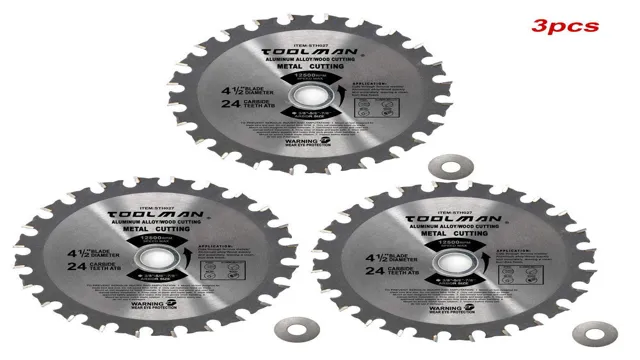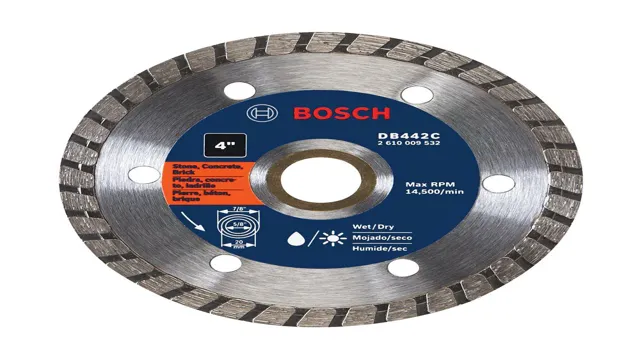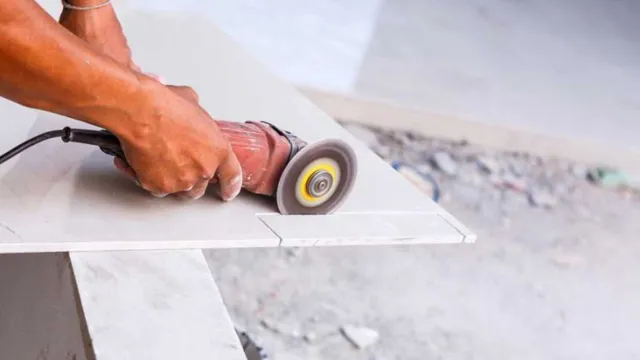What Angle Grinder Blade Cuts Metal? A Comprehensive Guide to Choosing the Best Blade for Cutting Metal

Looking for the perfect angle grinder blade to cut through metals like butter? Look no further! Metal cutting jobs require the right tool and the best angle grinder blade for the job. With so many options available in the market, it can be overwhelming to choose the perfect one. But don’t worry, we’ve got you covered! In this blog post, we’ll share some of the best metal cutting angle grinder blades that will make your work easy, accurate, and efficient.
We will also discuss the factors you need to consider before making a purchase. So sit back, relax, and read on!
Introduction
If you’re working with metal, you might be wondering what angle grinder blade is best for the job. The short answer is that a cut-off wheel is the blade you should be using to cut metal with your angle grinder. These wheels are specifically designed for cutting through metal, and are made with a reinforced material that helps prevent the blade from breaking or wearing down quickly.
When choosing a cut-off wheel, you’ll want to pay attention to the size of the disc, as well as the thickness of the blade. Depending on the size and thickness of the metal you’re cutting, you may need a larger or smaller blade. Additionally, you’ll want to make sure that the blade you choose is compatible with your angle grinder model.
With the right blade and the proper safety precautions, an angle grinder can be a great tool for cutting through metal quickly and efficiently.
Why Choose an Angle Grinder?
An angle grinder is a versatile tool that can be used for several different purposes. From cutting, grinding, and polishing to sanding and sharpening, an angle grinder is a must-have for any DIY enthusiast or professional worker. One of the reasons why you should consider choosing an angle grinder is its ability to handle a range of materials, including metal, stone, and wood.
Moreover, angle grinders come in different variations to suit different tasks, which means you can find one that works best for your specific needs. In addition, angle grinders are easy to use and can make your work much more efficient. Whether you’re working on a home renovation project or a commercial construction job, an angle grinder is a reliable and powerful tool that can help you get the job done.

Why is it Important to Choose the Right Blade for Your Angle Grinder?
Choosing the right blade for your angle grinder may seem like a small and insignificant decision, but it can make a big difference in the outcome of your project. Using the wrong blade can result in poor quality cuts, damaged machinery, and even injury. It is important to carefully consider the type of material you will be cutting, the thickness of the material, and the type of cut you need to make before selecting a blade.
By taking the time to choose the right blade for your angle grinder, you can ensure that your project is completed efficiently, safely, and with the highest level of precision possible. So, don’t underestimate the importance of this decision. Make sure you choose the right blade for the job at hand and enjoy a job well done.
Types of Angle Grinder Blades for Metal Cutting
If you’re looking to cut metal with an angle grinder, there are a few different types of blades to choose from. One popular option is the abrasive cutoff blade, which is designed to cut through tough materials like metal and concrete. These blades feature a tough abrasive material that grinds away at the metal as you cut, leaving a clean, precise edge.
Another type of blade to consider is the diamond cutoff blade, which uses diamond particles to grind through metal with ease. These blades are incredibly durable and can provide a smooth, polished cut that is ideal for finishing work. For heavier-duty jobs, you may want to opt for a carbide-tipped blade, which features a carbide insert that can withstand high temperatures and resist wear, making it ideal for cutting through tough metals.
Whatever blade you choose, make sure to select the right size and shape for your angle grinder to ensure the best possible results.
Diamond Blades
Diamond Blades When it comes to cutting metal with an angle grinder, it’s crucial to have the right blade for the job. There are several types of angle grinder blades available on the market, and each has its own unique features and benefits. One popular option is the diamond blade, which is incredibly durable and can handle tough materials like steel, iron, and aluminum.
Diamond blades use tiny diamond particles embedded in the metal to create a strong cutting edge. These blades are designed to quickly cut through metal with precision and ease, making them an excellent choice for those looking to get the job done efficiently. Whether you’re a professional metalworker or a DIY enthusiast, a diamond blade is a great investment for cutting metal with an angle grinder.
Abrasive Blades
If you are in the metalworking industry, you know that having the right tools for the job is essential. One of the most important tools you will need is an angle grinder blade for metal cutting. But with so many options on the market, it can be overwhelming trying to decide which one to use.
There are various types of blades available, including abrasive blades, diamond blades, and cutoff wheels. Abrasive blades are the most common type of blade and are ideal for cutting through metal quickly and efficiently. These blades feature a high-speed rotation that causes friction, which generates heat.
The heat then melts the metal, allowing the blade to cut through it with ease. Abrasive blades come in two categories: bonded and coated. Bonded blades are more durable and long-lasting, while coated blades are designed for more delicate jobs.
Overall, when choosing an abrasive blade for your angle grinder, consider the type of metal you will be cutting and the job’s requirements to ensure you get the best results.
Carbide Blades
Carbide Blades When it comes to working with metal, having the right angle grinder blade is essential. Carbide blades are the best option for cutting through hard metals such as steel and iron. These blades are made up of tungsten carbide, a material that is much harder than traditional steel blades.
There are two types of carbide blades: flat and toothed. Flat blades are designed for cutting through flat surfaces and provide smooth cuts, while toothed blades are great for cutting through thicker materials. Both types of blades can be used with angle grinders to make precise cuts.
One advantage of using carbide blades is that they provide a much longer lifespan than traditional steel blades. They can withstand heavy use and won’t dull as quickly, making them a cost-effective option in the long run. However, it’s important to note that carbide blades are much more brittle than steel blades and can break if used improperly.
It’s important to use them at the correct speed and to apply a light touch when cutting through thicker materials. With the proper usage, carbide blades are an excellent choice for those working with hard metals.
Factors to Consider When Choosing an Angle Grinder Blade for Metal Cutting
When it comes to metal cutting, choosing the right angle grinder blade is crucial. The first factor to consider is the blade’s size and thickness. The blade must fit the grinder and be thick enough to handle the task at hand.
Secondly, the blade’s material is essential. Carbide-tipped blades are the most durable, making them ideal for heavy-duty tasks. However, they are also more costly.
Diamond blades are another option and are perfect for cutting through hard metals. Finally, deciding on the blade’s teeth configuration is an important consideration. Blades with fewer teeth are better for rough and fast cutting, while those with many teeth offer cleaner and smoother cuts.
The right angle grinder blade makes all the difference in metal cutting, so it’s essential to consider these factors before making a purchase. Make sure to invest in a high-quality, well-suited blade to ensure a job well-done.
Size of the Blade
When choosing an angle grinder blade for metal cutting, the size of the blade is an important factor to consider. The size of the blade refers to its diameter, which can range from 5 inches to 9 inches.
The larger the blade, the more surface area it can cover and the faster it can cut through metal. However, larger blades also tend to be more expensive and heavier, which can be a concern if you plan on using the angle grinder for extended periods. Additionally, larger blades may require a more powerful angle grinder to handle the increased load.
On the other hand, smaller blades are more affordable and lightweight, making them a good choice if you have smaller cutting tasks. Ultimately, it’s important to choose a blade size that is appropriate for your specific cutting needs and the capabilities of your angle grinder.
Speed and Power of the Angle Grinder
Angle grinder blade for metal cutting When it comes to choosing an angle grinder blade for metal cutting, there are a few important factors to consider. One of the most crucial is the speed and power of your angle grinder. The higher the RPM and wattage of your tool, the faster and more efficient the cutting process will be.
Additionally, you’ll want to ensure that your blade is designed specifically for metal cutting, as not all blades are created equal. Look for blades with a high-quality abrasive material, such as aluminum oxide or zirconia alumina, that can withstand the tough demands of metal cutting. Another key consideration is the thickness of your blade.
Thicker blades can handle heavier-duty jobs, but may not be as maneuverable for intricate cutting. On the other hand, thin blades are more agile but may not last as long under heavy use. Ultimately, the right angle grinder blade for your metal cutting needs will depend on a variety of factors, including the size and nature of your workpiece, your experience level, and your personal preferences.
Type of Metal Being Cut
When it comes to choosing an angle grinder blade for metal cutting, the type of metal being cut is a crucial factor to consider. Different metals require different types of blades, and using the wrong one can lead to a subpar job or even dangerous accidents. For instance, if you’re cutting through thick and heavy-duty metals, a diamond blade may be the best option due to its strength and durability.
On the other hand, if you’re dealing with softer metals like copper or aluminum, a blade with finer and smaller teeth may be a better choice for smoother and more precise cuts without damaging the material. Therefore, before purchasing an angle grinder blade, ensure that you have a clear understanding of the type of metals you will be working on to make the right blade selection and achieve the best results.
Conclusion
In summary, an angle grinder blade designed for cutting metal utilizes a combination of brute force and precision to slice through tough materials like butter. With its sharp teeth and durable construction, it’s a cutting tool that would make even Wolverine jealous. So, if you need to trim some metal, don’t hesitate to grab your angle grinder and let the sparks fly!”
FAQs
What type of angle grinder blade should I use for cutting metal?
You should use a diamond-tipped or abrasive blade specifically designed for cutting metal with your angle grinder.
Can I use a regular cutting wheel on my angle grinder to cut metal?
No, using a regular cutting wheel on your angle grinder for cutting metal can be dangerous and cause the wheel to break apart. Always use a blade specifically designed for cutting metal.
How do I choose the right size blade for my angle grinder to cut metal?
You should choose a blade that is the same size as your angle grinder, typically 4.5 or 5 inches in diameter. Make sure to check the manufacturer’s instructions for compatibility.
What safety precautions should I take when using an angle grinder to cut metal?
Wear eye and ear protection, use gloves and long sleeves, secure the workpiece, and use the appropriate guard on the grinder to prevent sparks and debris from hitting you.
What is the best way to make straight cuts in metal with an angle grinder?
Clamp a straight edge onto the metal surface and use it as a guide for the angle grinder blade. This will ensure a straight and accurate cut.
How do I prevent the blade from overheating when cutting metal with an angle grinder?
Avoid pressing down too hard on the grinder and take breaks to allow the blade to cool down. You can also use cutting oil to lubricate the blade and reduce heat buildup.
Can I use an angle grinder to cut through thick metal?
Yes, but you may need to use multiple passes or switch to a larger blade to make the cut. Make sure to take breaks and allow the blade to cool down between passes.



